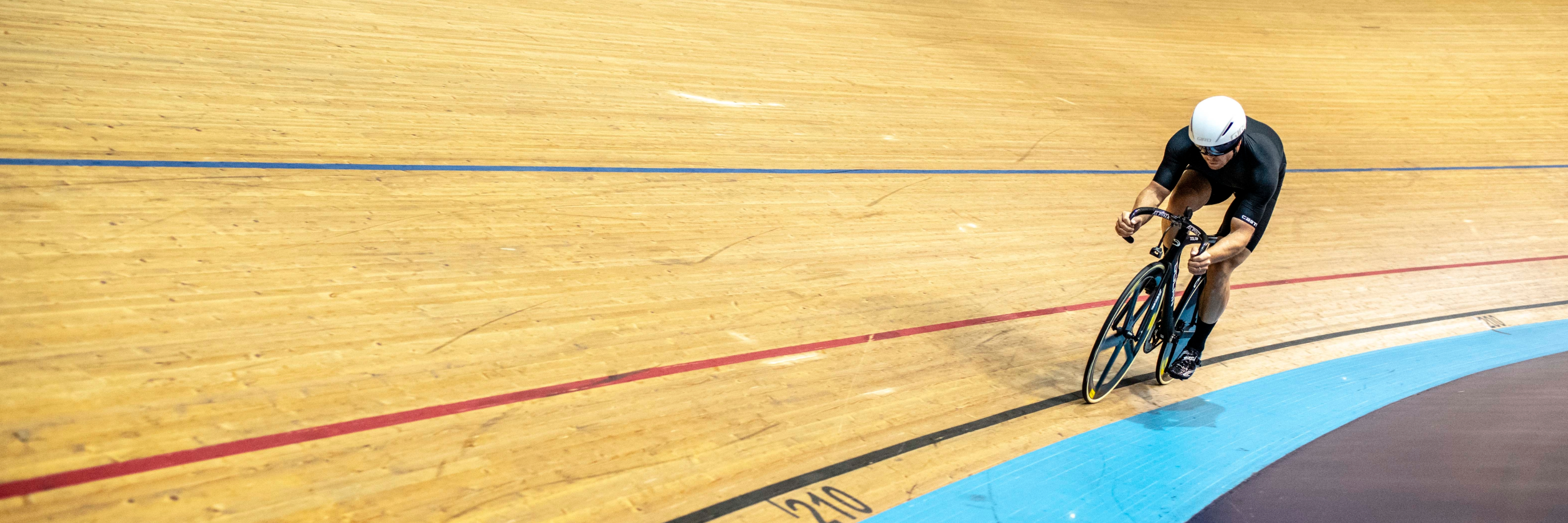Introduction
This test was set up to demonstrate how the full aerosensor Aerodynamic Cycling System (ACS) can be used to optimise aerodynamic drag.
Elite cycling & triathlon performance coach Matt Bottrill undertook the test at the outdoor velodrome in Halesowen.
During the test we looked at various different helmets and also variation in body position to establish any differences in drag.

Figure 1: Matt Bottrill with aerosensor and aerobody.
Test
All ACS products were used in the test:
The ACS uses Aerosensor (measures aerodynamic drag), as well as Aerobody (measures variation in head and chest height), and Aerodrome- a precise lap timing device. All data was visible to Matt via the Garmin Edge computer interface in real-time.
Velodrome mode was used where elevation changes are ignored, and a trackmap used to account for the lean angles in the turns - Halesowen Velodrome is 400m long, with approx. 100m long straights, resulting in a lean angle of around 20° at 40kph.
For each run Matt completed 8 laps with a nominally constant body position (any variation was shown in real-time to Matt by Aerobody), cycling at around 45kph. The first session looked at several different helmets - with the Kask Mistral XL helmet run repeated to establish repeatability across the test block:
- Endura Drag2Zero helmet
- Kask Mistral XL helmet
- Kask Bambino pro evo helmet
- HJC Adwatt helmet
- Caddex helmet

Figure 2a: Kask Bambino helmet test run.

Figure 2b: Caddex helmet test run
In the second session we tested two different body positions, to simulate a set up change for the rider:
- High hands
- Bars moved 40mm rearwards (low hands)

Figure 3a: Kask Mistral helmet (hands high position)

Figure 3b: Kask Mistral helmet (hands low position)
Results
During the test there was a strong gusting wind, and as a result yaw and headwind variation was quite high - which will have an adverse effect on wind conditions.
One of the advantages of Aerosensor is the very accurate and fast-responding wind measurement - the wind yaw angle time history for a typical run is as follows (data is from the FIT file, recorded at 1Hz):

Figure 4: Wind yaw angle time history from Aerosensor
For each run we can look at yaw and headwind distribution:
Figure 5a: Yaw Angle Distribution

Figure 5b: Headwind distribution
Test results from the helmet comparison are shown below:
| Run | Description | Head height (cm) | Chest height (cm) | CdA | Delta CdA | Delta Power @ 40kph (W) |
| 1 | Endura baseline | 3.9 | 25.7 | 0.219 | ||
| 2 | Endura repeat | 4.0 | 25.9 | 0.219 | -0.005 | -0.1 |
| 3 | Kask Mistral XL | 5.0 | 25.7 | 0.214 | -0.005 | -3.8 |
| 4 | Kask Bambino pro evo | 3.9 | 25.0 | 0.216 | -0.003 | -2.1 |
| 5 | HJC Adwatt | 4.6 | 26.1 | 0.218 | -0.001 | -0.5 |
| 6 | Kask Mistral XL repeat | 5.5 | 25.7 | 0.213 | -0.006 | -4.7 |
| 7 | Caddex | 3.8 | 24.6 | 0.217 | -0.002 | -1.7 |
Table 1: CdA for the range of tested helmets
Test results from the position comparison are shown below:
| Run | Description | Head height (cm) | Chest height (cm) | CdA | Delta CdA | Delta Power @ 40kph (W) |
| 6 | Kask Mistral XL repeat | 5.5 | 25.7 | 0.213 | - | - |
| 8 | High hands | 6.7 | 25.3 | 0.210 | -0.003 | -2.5 |
| 9 | Bars moved 40mm rearwards (low hands) | 4.8 | 2.8 | 0.210 | -0.003 | -2.3 |
Table 2: CdA for the range of tested positions using the Kask Mistral XL helmet
Conclusions
- The Kask Mistral XL helmet was the best in test (largest reduction of power required, around 4W at 45kph). Backed up by 0.5% error between the repeat runs – suitably small to have confidence in the ‘best in test’ conclusion (table 1)
- Both position tweaks resulted in around a 2.5W improvement over baseline (table 2)
- With the high hands position, Matt had to lift his head to see where he was going, but despite this still resulted in a drop in overall drag – which suggests a powerful position. This is something that is likely to be missed in the wind tunnel, and a notable advantage to real-world testing, made possible with Aerosensor.
If you'd like to get in touch regarding our devices, or if you have any questions please contact us at hello@aerosensor.tech
